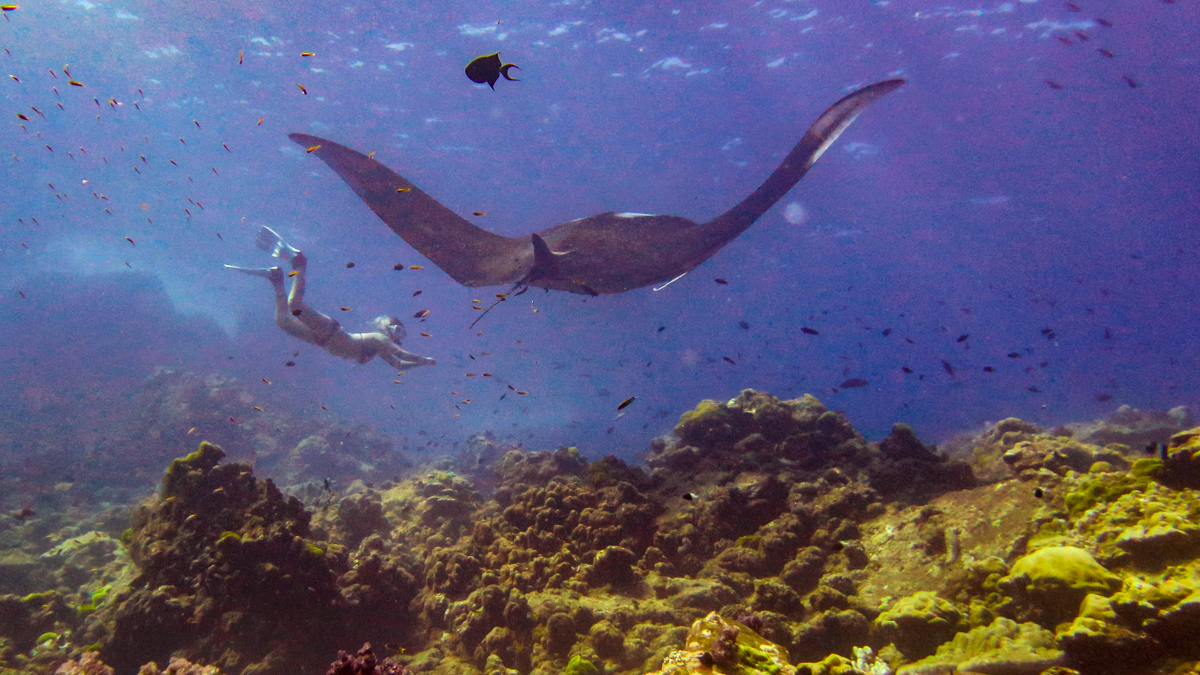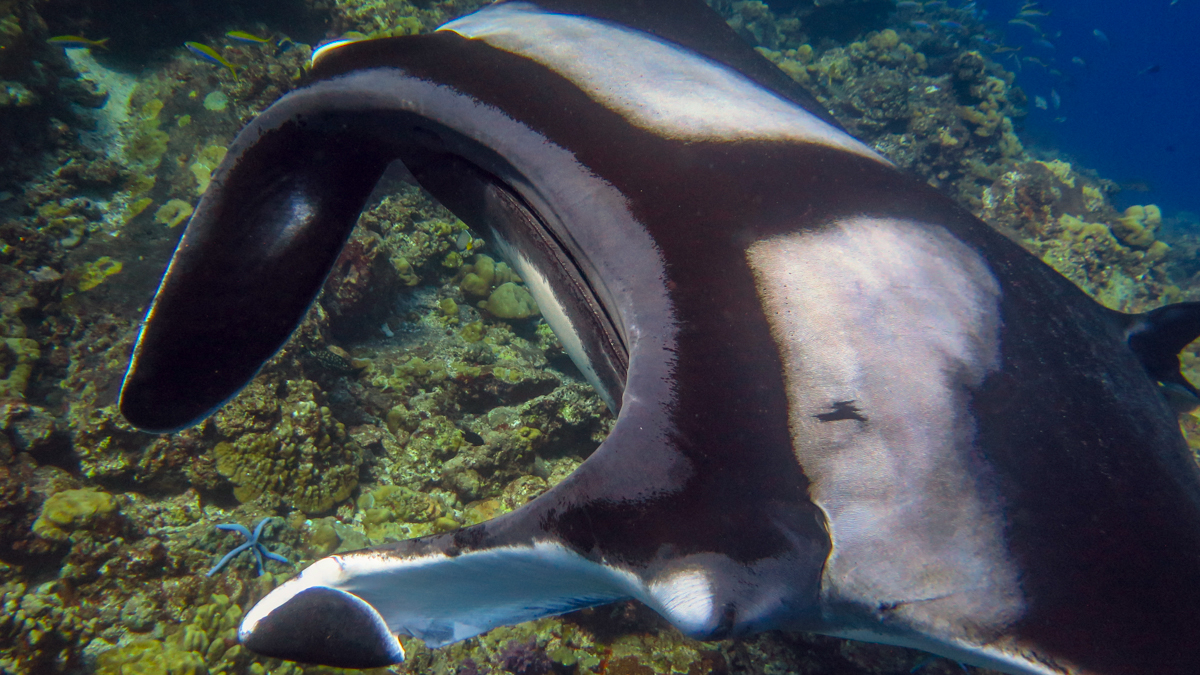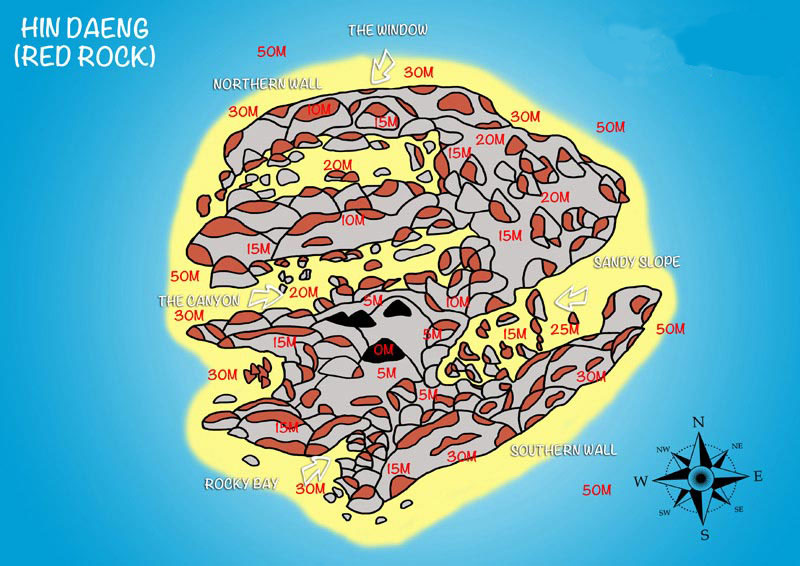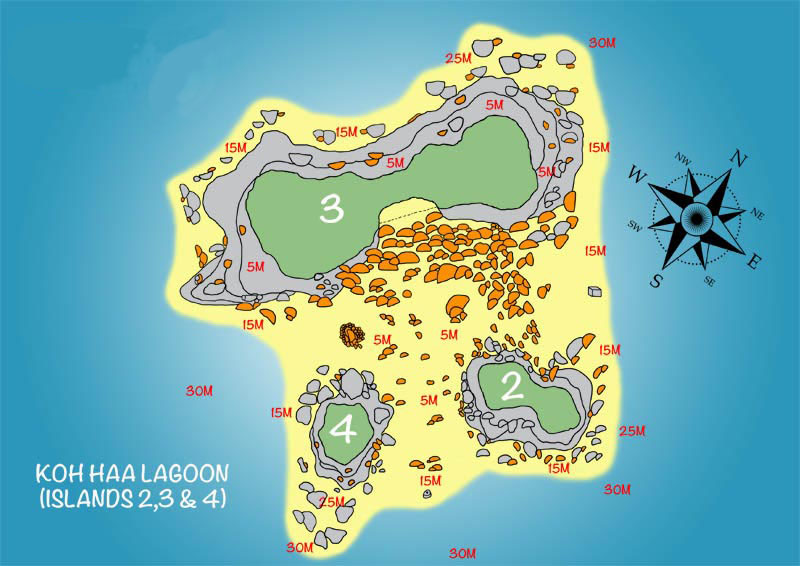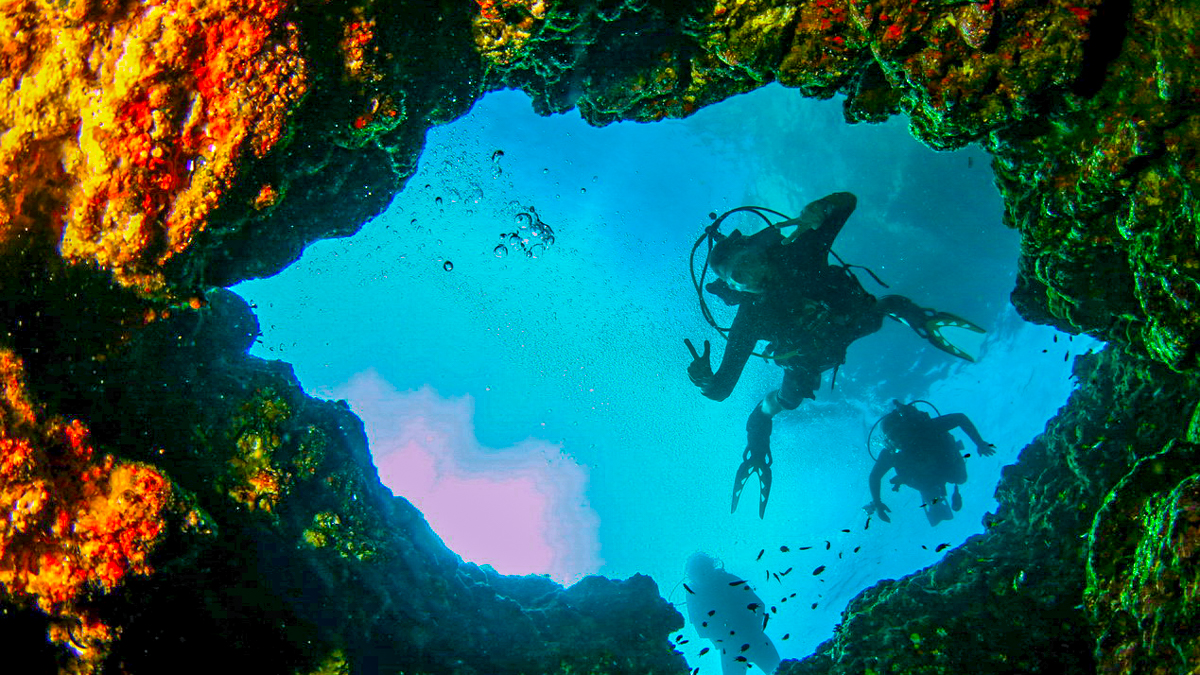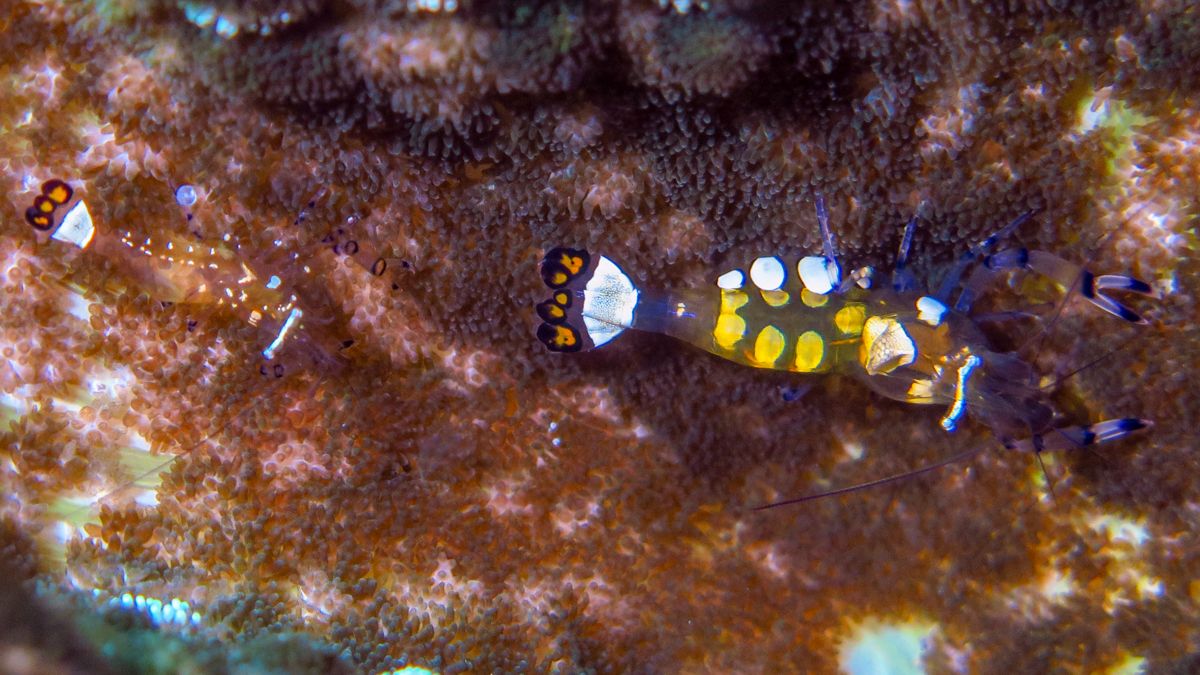Hin Muang
General information: Two underwater rocks to the west of Hin Daeng are called Hin Muang, which means “purple rock” in Thai. The name is given in accordance with the predominant color of the corals growing on these rocks.
The rocks are long and narrow in shape and resemble a French baguette bread. There are several reefs underwater with cliffs on the sides, dropping into a sandy bottom at a depth of 45-60 meters. The cliffs around Hin Muang are rich in marine life and are covered in soft corals, gorgonians, sea fans and black corals.
There are two mooring buoys on the surface. One of them is located in the west, not far from the strait, in the place where a split formed in the rock at a depth of 14 meters.
To the west of this buoy there is a carpet of anemones at a depth of 8 meters, which is the shallowest part of this dive site. To the east of this buoy, there is a number of underwater peaks at a depth of 12-16 meters. Nearby is another mooring buoy, anchored at a depth of 22 meters, where the bottom is formed of sand and stones.
Current: moderate to strong northeast to southwest and vice versa.
Marine flora and fauna: Hin Muang is a true oasis in the southern part of the Andaman Sea.
This place attracts an unimaginable number of pelagic species such as sea devils and whale sharks, especially during the plankton bloom (around the end of March and April).
The cliff area is home to a variety of tropical reef fish, including schools of rainbow mackerels, barracuda, swallow fish, and groupers and snappers. Giant moray eels usually hide in crevices of rocks, while leopard sharks, gray reef sharks and marble stingrays are often found near the sandy bottom.
Various macro-forms of marine life can be found in this area, such as harlequin pipe-snails, spotted harlequin shrimp and a huge variety of nudibranchs. In the shadows of vast thickets of black coral, you will find a long-snouted curler.
Useful tip: The depth of the vertical wall on Hin Muang is relatively large, especially where it goes beyond amateur diving.
To avoid exceeding the no-decompression limit, it is important that you remember the type of dive and do not exceed this limit.
Since the reef is quite long, dives usually start from a marker buoy and then work north or south, using the underwater cliffs as shelter from the strong current. Start at the west buoy and head east, then head back to the buoy for a safety stop. Completing the dive on the east side of the site is difficult due to the depth of the rocks.
Hin Daeng
General information: If Richelieu Rock is considered the pearl of the northern territory of the Andaman Sea, then the twin rocks Hin Daeng and Hin Muang are undoubtedly the most interesting diving spots in the south of the Andaman Sea.
Hin Daeng – in Thai means “red rock”. The name comes from the red-colored soft corals that cover the rock. Only three small towers are visible from the surface of the water, but under water they stretch down to the sandy bottom at 30-40 meters depth.
A long rock wall, rich in soft corals, sea fans and black corals, stretches from the west to the south of the Hin Daeng cliff and reaches a sandy bottom 40-45 meters deep.
On the other hand, the eastern and northeastern part is a reef slope with turrets and hard corals, which descends to the sandy bottom to a depth of 35-40 meters. On the north side of Hin Daeng, there is a large canal that takes you to the west side.
The hard corals that cover the summits are great for snorkeling. The average depth here is only 5-10 meters.
Current: northeast to southwest, and vice versa.
Marine flora and fauna so varied that it takes your breath away. The assortment of reef fish in the rocky area is fairly typical of the Andaman Sea.
This is one of the few places where you can see manta rays hovering in small groups of 3-4. Particularly during the peak season (February – April), whale sharks can be seen lingering in these areas for feeding.
During the daytime, active nocturnal predators such as zebra and gray reef sharks rest on the bottom. You might also be lucky enough to witness moray eels hunting. It should be noted that rainbow mackerel, horse mackerel, cesium, long-finned platax and striped barracuda are common in the waters near the rocks.
Near the rock wall, you will find many types of macro creatures such as pipe-snouted harlequins, spotted harlequin shrimp, long-snouted curler and nudibranch.
Useful tip: The sandy bottom is quite deep, so avoid decompression dives and always watch the depth. Hin Daeng is ideal for day and night diving, however avoid periods with strong currents.
Koh Ha Neua
General information: Koh Ha Neua is the northernmost island of the Koh Ha group of islands and is surrounded by interesting diving sites.
The island is surrounded on all sides by a reef. The north coast has a wall that is covered in soft corals, sea fans and barrel sponges. On the southeastern side of the island, there is a reef slope of hard coral. The maximum depth of the dive site does not exceed 25-30 meters.
The most interesting dive site is on the south side of the island. It is remarkable for its extraordinary rocks, which are covered with dense thickets of soft corals and sea fans, and which formed a unique underwater tunnel. Another popular place is the grotto at a depth of 16-18 meters, from which the so-called “chimney” or vertical cave leads, from which there are two exits at a depth of about 5 meters.
Current: calm to moderate at the edge of the island, east-west, and vice versa.
Marine flora and fauna: Stingrays, zebra sharks, moray eels, scorpions and puffers come here. Examine the cracks carefully and you are likely to spot a decorated pipe nozzle or rare species such as the striped pipit or the eye-catching harlequin shrimp.
If you want to see flocks of cesium and yellow-tailed barracuda, head to the west coast of the island.
Useful tip: Diving through the “chimney” will be an unforgettable adventure, but you need to know that its inner part is very narrow, and in order to avoid any ailments from pressure drops, as you climb along the chimney (especially through the narrow eastern exit), the diver needs a clear buoyancy control.
Only experienced divers are allowed to enter the tube.
Plan your dive carefully and avoid situations where you need to randomly change your depth many times.
Koh Ha Lagoon
General information: Located in the middle of the Koh Ha group of islands, Koh Ha Lagoon is a 5m deep area surrounded by a pair of limestone towers Koh Ha 2 and Koh Ha 4 to the east, and Koh Ha 3 to the west.
The limestone towers to the east are the most famous diving spots in the lagoon.
The South Tower, covered with colorful soft corals, huge sea fans, black corals, anemones and orange goblet corals, has formed the relief of the island’s south side.
The outer side of the tower is covered with a sandy bottom at a depth of 24 meters. Behind the wall, where large rocks are scattered, there are many perches, and the sloping area connecting the two islands is home to many hard corals.
The North Tower is very similar to the South Tower, except that everything is here on a larger scale.
Koh Haa 3, a long island west of the lagoon, is also a good dive site, although a bit less well known than the other two towers.
Current: calm to moderate in a north-south direction and vice versa. In the center of the bay, as a rule, there are almost no currents.
Marine flora and fauna: The dive site is perfect for fans of macro creatures. Many cracks and crevices in the limestone rocks act as a refuge for crabs and shrimps.
On the wall are sea fans that attract decorated pipe-noses and sea gastropods that camouflage themselves among the coral branches. Lobsters, squid, harlequin shrimp and pegasus fish are found between the islands, and many species of nudibranch live right on the walls of the reef.
During the night dive, you can watch how the orange goblet corals feed, grabbing the unfortunate victim with their tentacles.
But, as they say, every cloud has a silver lining, because if you look at the whole picture of what is happening, you can see small sea snails feasting on the polyps of these amazing orange corals.
Useful tip: Most dive boats moor in the middle of the bay. You can start the dive at the mooring end, then sail to the twin towers and return back at the end.
Alternatively, divers have the opportunity to explore the western island, which is also a good dive site.
Don’t miss the night dives on Koh Ha Lagoon. At night, orange goblet corals can be seen opening their beautiful polyps. However, outside the bay, be careful about the strength and direction of the current, especially during night dives.
Koh Ha Yai
General information: Koh Ha Yai is the largest island in the Koh Ha group of islands. Its distinctive feature is a steep cliff, perpendicular to sea level and which extends from the surface of the water to a depth of 30 meters.
Koh Ha Yai is surrounded by reefs. The most famous dive site is the stone wall on the south side of the island, which goes down to the sandy bottom to a depth of 25-30 meters. It is covered with many soft and hard corals and sea fans.
There are two underwater caves on the south side of the island. The entrance to the first cave is at a depth of 12 meters. The deeper into the cave, the narrower it becomes, so diving in it is recommended only if you have received a professional cave diving certificate.
The second cave is located east of the first and is smaller in size. The cave entrance is divided into two parts by a vertical rock, however the rest of the cave is quite spacious and well lit. The height of the large hall is 2-3 meters above sea level, so it is possible to ascend to the surface from the cave. The cave is also known as the “cathedral” because of the blue light coming from the surface. The outer side of the cave is covered with soft corals, sea fans and outcrops and rests on a sandy bottom at a depth of 28-30 meters.
Current: calm to moderate east-west and vice versa.
Marine flora and fauna: Zebra sharks and stingrays are often found on the sandy bottom. Young lobsters and a variety of nudibranchs can be seen in the crevices of the rocks, especially at the cave entrance.
Look closely and you may also find a harlequin pipe nozzle camouflaged among sea fans or soft corals.
Schools of squid and yellow-tailed barracuda are usually found near the water surface close to the cave entrance. If you shine a lantern into the cave, you will see the reflection emanating from many sweepers (Pempheris oualensis). Bissa sea turtles sometimes come here.
Useful tip: The real “pearl” of the dive site is the cathedral cave. You will have an unforgettable experience as the sun’s rays penetrate into the cave and illuminate it with crystal blue light.
In case of strong sea waves, divers are strictly not recommended to enter the cave, as they can easily be pressed against the walls of the cave and injure themselves on sharp rocks or from the bites of marine life.
Compared to the “cathedral”, the dimensions of the first cave are small, and the space inside is narrower and more confusing. Entry to this cave is only permitted if the diver has received a professional cave diving certificate or is in the process of training with a qualified instructor.
You can visit these dive sites on the Giamani, Gentle Giant, The Junk safari boats or individually on our boat.
Nine pearls of the Similan archipelago
SIMILAN ISLANDS: A DIVER’S PARADISE AND BEYOND
SIMILANS – RICHELIEU ROCK DIVE SITE


